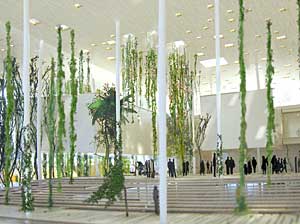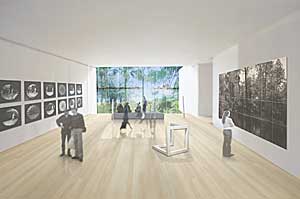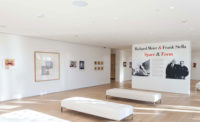Herzog & de Meuron Tap Tropical Climate for Design Ideas
It’s not quite the Hanging Gardens of Babylon, but it will come close enough to stir a visitor’s imagination just the same. Herzog & de Meuron’s design for the new Miami Art Museum (MAM) aims to produce a living building where the outdoors come inside to frame galleries that bridge continents and cultures.
 Image © Herzog & de Meuron |
| A large roof will shelter a series of gallery volumes, located on an elevated terrace, at the new Miami Art Museum. |
When the new $220 million facility opens in 2011, it promises to transform a four-acre plot in a neglected park on the city’s downtown waterfront into a major museum complex. The design draws from the Swiss duo’s approach of analyzing the needs of a city, a site, and an institution—the result offers a civic space where community, nature, art, and architecture are harmoniously united.


Images © Herzog & de Meuron
Underneath the roof, hanging gardens will be rooted into the structure of columns and brace frames (top). Galleries will feature views of the gardens and the museum’s waterfront site (above).
“We tried to create a seamless indoor-outdoor experience, an architectural answer to the climatic conditions, and a project that integrally includes vegetation and architecture,” says Christine Binswanger, a partner with Herzog & de Meuron, which has experience designing museums throughout the world including the Forum Building in Barcelona and the Tate Modern in London.
The indoor-outdoor goal spawned an elevated, open-air terrace shaded by a broad roof of perforated slabs. A hanging garden will literally be rooted into the structure of columns and brace frames. It will help visitors gradually transition from Miami’s tropical climate to the museum’s more regulated interior.
Under this roof, the park will transition into a dense, multi-dimensional garden with a series of floating volumes. The museum building itself, totaling 120,000 square feet, is at the core. A wide stair will connect the platform to the sea and a promenade.
In addition to the roof and hanging gardens, Herzog & de Meuron incorporated a variety of strategies to reduce energy demands. Although specific details have yet to be released, the building will feature state-of-the-art technologies that exploit natural resources, such as ground temperature, wind, and sun.
The design also represents an experimental merger of advanced curatorial and architectural concepts with a set of gallery types that aim to establish a new paradigm for the collection and display of artwork. Arranged in a non-linear sequence, four gallery types will allow visitors the freedom to flow through the museum in multiple directions, stepping freely into and out of the various kinds of aesthetic encounters, rather than being led through a sequence of standardized white cubes.
“The Miami Art Museum is a place for the entire community—not just art addicts—and that resulted in a generous offer of public space in the design,” Binswanger says. “Visitors will have the freedom to flow through the museum in many directions instead of following a traditional flow of cubes.”



